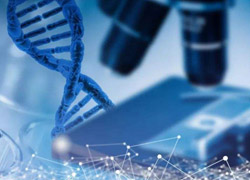Industry news
Selection, preparation, sterilization and disinfection of commonly used media
time:2020-12-03 view count:262
When choosing a basic medium, in addition to the genotype of the plant to be cultivated, the type of medium should usually be considered, its total ion concentration, total nitrogen level and nitrogen source type (nitrate nitrogen and ammonium nitrogen) and ratio, calcium and chlorine The content of the compound, etc. MS medium is widely used for herb tissue culture, while woody plant tissue culture usually uses low-salt basic medium such as 1/2 or 1/4 MS or WPM (Woody Plant Medium). In addition to the total ion concentration, the total nitrogen level, the type of nitrogen source (nitrate nitrogen and ammonium nitrogen) and the ratio also have a great influence on tissue culture, so changing the type and concentration of the nitrogen source of the basic medium according to the specific conditions can improve the culture effect [15~17].
Different genotypes may require different basic media, but the same plant requires different basic media at different stages of cultivation or for different purposes. Generally, according to the culture stage and purpose, it can be divided into start-up or induction medium, proliferation medium, rooting medium, etc. This division may only be the adjustment of hormones, or the change of some components of the same basic medium, or even basic culture The base type is different. For example, most plants use 1/2~1/4 MS or other low-salt medium such as White medium during rooting culture, somatic embryogenesis often changes the type and ratio of nitrogen sources at different stages. The type of basic medium may also affect the effect of growth regulators, so it is necessary to consider the interaction between different basic culture media and different concentrations of growth regulators.
Usually, before tissue culture of a plant, you should first search for relevant information about plant tissue culture of the same genus, species or species, and refer to previous research results. If you cant find the relevant information, you can start the experiment with some well-known basic media such as MS, WPM or B5. If the screening effect of the existing basic medium is not satisfactory, it can be improved based on the basic medium such as MS, WPM or B5. Generally, there are the following ways to improve:
(1) Reduce the large number of components or inorganic salt components of the basic medium by half to three-quarters (1/2, 1/3, 2/3, 1/4, or 3/4), or different basic medium Component combination, such as combining the inorganic salt component of B5 with the organic component of MS, etc.;
(2) Increase or decrease the level of nitrogen sources and adjust the types and proportions of ammonium nitrogen and nitrate nitrogen (ammonium salts and nitrates). Nitrogen sources usually have a greater impact on the quality and development of the culture;
(3) Increase calcium salt to improve calcium deficiency in woody plant cultivation;
(4) Add a variety of vitamins, amino acids and organic additives, which are more effective for plants with complex nutritional requirements or difficult to cultivate;
(5) Measure the nutrient content in the soil and body for plant growth to provide reference for the improvement of the basic medium;
(6) Divide the inorganic salt, organic ingredients, auxin and cytokinin into three levels: high, medium, and low, and conduct 81 (34) combination tests, which is more accurate. In short, the basic culture medium suitable for the specific requirements of the established plant material can be optimized and selected by adjusting the quality (composition) and quantity (concentration) of the medium.
Factors that often change in plant tissue culture media are growth regulators, especially auxins and cytokinins. The type, quantity and ratio of auxin and cytokinin are usually determined based on experience or the nature and function of the hormone. But a more scientific method is to use single factor test method and multi factor test method (orthogonal design), so that the results can be analyzed by biostatistics method. For example, based on a basic medium, auxin (such as NAA) and cytokinin (such as BA) are each at 9 concentration levels (0, 0.5, 1.0, 1.5, 2.0, 2.5, 3.0, 3.5, 4.0 mg /l) The combination of 81 treatments can get a better combination of auxin and cytokinin concentration levels. Although orthogonal design is scientific and reasonable, taking into account the interaction between the two types of elements, but the workload is relatively large.
In practice, it is also possible to fix the concentration of auxin, change the type or concentration of cytokinin, and select a better type and concentration of cytokinin; and the same method can be used to select auxin. Or sometimes in order to reduce the workload, several combinations (such as the one with relatively high auxin concentration, the one with high cytokinin concentration, and the one with balanced auxin and cytokinin) can be prepared in a representative quantity of several combinations. ), first determine which type is more suitable, and then according to the suitable type, use single factor or multi-factor test method to further determine the more suitable hormone combination. The method for determining suitable factors such as light and temperature is also the same.
Preparation, sterilization and disinfection:
1. The purpose of the experiment
Understand the principle of culture medium preparation; master the general methods and steps of preparing culture medium; understand the basic principles and methods of common sterilization and detoxification; master the operation methods of dry-hot bacteria, high-pressure steam sterilization and filtration sterilization.
2. Experimental principle
The culture medium is a mixture of nutrients required for the growth and reproduction of microorganisms and the synthesis of metabolites artificially prepared in a certain proportion. The raw materials of the culture medium can be divided into carbon sources, nitrogen sources, inorganic salts, growth factors and water. Depending on the types of microorganisms and experimental purposes, there are also different types and preparation methods for culture media.
Beef extract peptone medium is a widely used and common bacterial basal medium, sometimes also called ordinary medium. Since this medium contains the basic nutrients required for general cell growth and reproduction, it can be used for the growth and reproduction of microorganisms.
Dry-hot bacteria and high-pressure steam sterilization methods are mainly to denature protein by heating up to achieve the effect of killing microorganisms.
3. Reagents and equipment
1. Equipment
Test tube, triangular flask, beaker, measuring cylinder, glass rod, culture medium, dispenser, balance, horn spoon, autoclave, pH paper, cotton, kraft paper, marker pen, twine, gauze, straw, petri dish , Electric oven, syringe, microporous membrane filter, tweezers, etc.
2. Reagents beef extract, peptone, NaCl, agar
4. Experimental content
1. Weighing → melting → pH adjustment → filtration → dispensing → stoppering → dressing → sterilization → sterility inspection
2. Dry heat sterilization: load the items to be sterilized→heat up→constant temperature→cool down→open the box
3. High pressure steam sterilization: add water → load items → cap → heat → exhaust cold air → pressurize → constant pressure → reduce pressure to zero → exhaust steam → take objects → sterility inspection
4. Sterilization by filtration: assembly and sterilization→connection→press filter→sterile inspection→washing and sterilization
5. Key steps and precautions
1. Prepare strictly according to the formula.
2. Do not over-adjust the pH.
3. Dry heat sterilization should be careful not to stack the items too tightly, pay attention to the time control of the temperature, and place and take the items below 70oC.
4. To autoclave sterilization, pay attention to not too many items. After heating, remove the cold air, and then reduce the pressure to zero to take the items.
5. Filtration and sterilization should pay attention to the sterilization of all parts. When pressing, the pressure should be appropriate, not too strong or too fast, and the filter membrane should be cleaned and stored.
Different genotypes may require different basic media, but the same plant requires different basic media at different stages of cultivation or for different purposes. Generally, according to the culture stage and purpose, it can be divided into start-up or induction medium, proliferation medium, rooting medium, etc. This division may only be the adjustment of hormones, or the change of some components of the same basic medium, or even basic culture The base type is different. For example, most plants use 1/2~1/4 MS or other low-salt medium such as White medium during rooting culture, somatic embryogenesis often changes the type and ratio of nitrogen sources at different stages. The type of basic medium may also affect the effect of growth regulators, so it is necessary to consider the interaction between different basic culture media and different concentrations of growth regulators.
Usually, before tissue culture of a plant, you should first search for relevant information about plant tissue culture of the same genus, species or species, and refer to previous research results. If you cant find the relevant information, you can start the experiment with some well-known basic media such as MS, WPM or B5. If the screening effect of the existing basic medium is not satisfactory, it can be improved based on the basic medium such as MS, WPM or B5. Generally, there are the following ways to improve:
(1) Reduce the large number of components or inorganic salt components of the basic medium by half to three-quarters (1/2, 1/3, 2/3, 1/4, or 3/4), or different basic medium Component combination, such as combining the inorganic salt component of B5 with the organic component of MS, etc.;
(2) Increase or decrease the level of nitrogen sources and adjust the types and proportions of ammonium nitrogen and nitrate nitrogen (ammonium salts and nitrates). Nitrogen sources usually have a greater impact on the quality and development of the culture;
(3) Increase calcium salt to improve calcium deficiency in woody plant cultivation;
(4) Add a variety of vitamins, amino acids and organic additives, which are more effective for plants with complex nutritional requirements or difficult to cultivate;
(5) Measure the nutrient content in the soil and body for plant growth to provide reference for the improvement of the basic medium;
(6) Divide the inorganic salt, organic ingredients, auxin and cytokinin into three levels: high, medium, and low, and conduct 81 (34) combination tests, which is more accurate. In short, the basic culture medium suitable for the specific requirements of the established plant material can be optimized and selected by adjusting the quality (composition) and quantity (concentration) of the medium.
Factors that often change in plant tissue culture media are growth regulators, especially auxins and cytokinins. The type, quantity and ratio of auxin and cytokinin are usually determined based on experience or the nature and function of the hormone. But a more scientific method is to use single factor test method and multi factor test method (orthogonal design), so that the results can be analyzed by biostatistics method. For example, based on a basic medium, auxin (such as NAA) and cytokinin (such as BA) are each at 9 concentration levels (0, 0.5, 1.0, 1.5, 2.0, 2.5, 3.0, 3.5, 4.0 mg /l) The combination of 81 treatments can get a better combination of auxin and cytokinin concentration levels. Although orthogonal design is scientific and reasonable, taking into account the interaction between the two types of elements, but the workload is relatively large.
In practice, it is also possible to fix the concentration of auxin, change the type or concentration of cytokinin, and select a better type and concentration of cytokinin; and the same method can be used to select auxin. Or sometimes in order to reduce the workload, several combinations (such as the one with relatively high auxin concentration, the one with high cytokinin concentration, and the one with balanced auxin and cytokinin) can be prepared in a representative quantity of several combinations. ), first determine which type is more suitable, and then according to the suitable type, use single factor or multi-factor test method to further determine the more suitable hormone combination. The method for determining suitable factors such as light and temperature is also the same.
Preparation, sterilization and disinfection:
1. The purpose of the experiment
Understand the principle of culture medium preparation; master the general methods and steps of preparing culture medium; understand the basic principles and methods of common sterilization and detoxification; master the operation methods of dry-hot bacteria, high-pressure steam sterilization and filtration sterilization.
2. Experimental principle
The culture medium is a mixture of nutrients required for the growth and reproduction of microorganisms and the synthesis of metabolites artificially prepared in a certain proportion. The raw materials of the culture medium can be divided into carbon sources, nitrogen sources, inorganic salts, growth factors and water. Depending on the types of microorganisms and experimental purposes, there are also different types and preparation methods for culture media.
Beef extract peptone medium is a widely used and common bacterial basal medium, sometimes also called ordinary medium. Since this medium contains the basic nutrients required for general cell growth and reproduction, it can be used for the growth and reproduction of microorganisms.
Dry-hot bacteria and high-pressure steam sterilization methods are mainly to denature protein by heating up to achieve the effect of killing microorganisms.
3. Reagents and equipment
1. Equipment
Test tube, triangular flask, beaker, measuring cylinder, glass rod, culture medium, dispenser, balance, horn spoon, autoclave, pH paper, cotton, kraft paper, marker pen, twine, gauze, straw, petri dish , Electric oven, syringe, microporous membrane filter, tweezers, etc.
2. Reagents beef extract, peptone, NaCl, agar
4. Experimental content
1. Weighing → melting → pH adjustment → filtration → dispensing → stoppering → dressing → sterilization → sterility inspection
2. Dry heat sterilization: load the items to be sterilized→heat up→constant temperature→cool down→open the box
3. High pressure steam sterilization: add water → load items → cap → heat → exhaust cold air → pressurize → constant pressure → reduce pressure to zero → exhaust steam → take objects → sterility inspection
4. Sterilization by filtration: assembly and sterilization→connection→press filter→sterile inspection→washing and sterilization
5. Key steps and precautions
1. Prepare strictly according to the formula.
2. Do not over-adjust the pH.
3. Dry heat sterilization should be careful not to stack the items too tightly, pay attention to the time control of the temperature, and place and take the items below 70oC.
4. To autoclave sterilization, pay attention to not too many items. After heating, remove the cold air, and then reduce the pressure to zero to take the items.
5. Filtration and sterilization should pay attention to the sterilization of all parts. When pressing, the pressure should be appropriate, not too strong or too fast, and the filter membrane should be cleaned and stored.



























